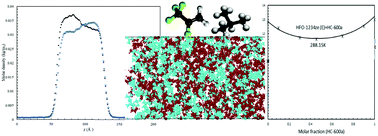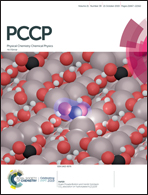Interfacial anomaly in low global warming potential refrigerant blends as predicted by molecular dynamics simulations†
Abstract
Understanding the phase behavior and accurately predicting the thermophysical, interfacial and transport properties of low global warming, fourth generation refrigerants is essential for designing and evaluating refrigeration cycle performances and determining the optimal refrigerant or blends for a selected application. In this paper, we have used molecular dynamics simulations to study the vapour–liquid interface of fourth generation refrigerants including 2,3,3,3-tetrafluoropropene (HFO-1234yf), trans-1,3,3,3-tetrafluoropropene (HFO-1234ze(E)), methylpropane (isobutane, HC-600a) and binary mixtures containing HFO-1234yf + HC-600a and HFO-1234ze(E) + HC-600a as new alternatives to third generation refrigerants. We provide predictions on their vapour–liquid equilibrium and interfacial properties (such as density profiles, interface thickness and surface tension) derived from the simulations. The results are compared to the experimental data, when available, and calculations made using the statistical associating fluid theory (SAFT). It is found that the mixtures of HFO-1234yf + HC-600a and HFO-1234ze(E) + HC-600a present azeotropic and aneotropic behavior. Molecular dynamics simulations corroborate the aneotrope already predicted by SAFT for these mixtures, highlighting the robustness of using molecular modeling techniques to investigate the performance of low GWP refrigerants and their blends as complementary tools to obtain the required data for the optimization of these systems. Insights into the molecular behavior at compositions before the aneotrope, at the aneotrope and after the aneotrope are provided based on radial distribution functions. It is shown that HC-600a and HFO molecules tend to stay closer to the same type of molecules and accumulate at different sides of the liquid region to act like pure components at the aneotropic composition.



 Please wait while we load your content...
Please wait while we load your content...